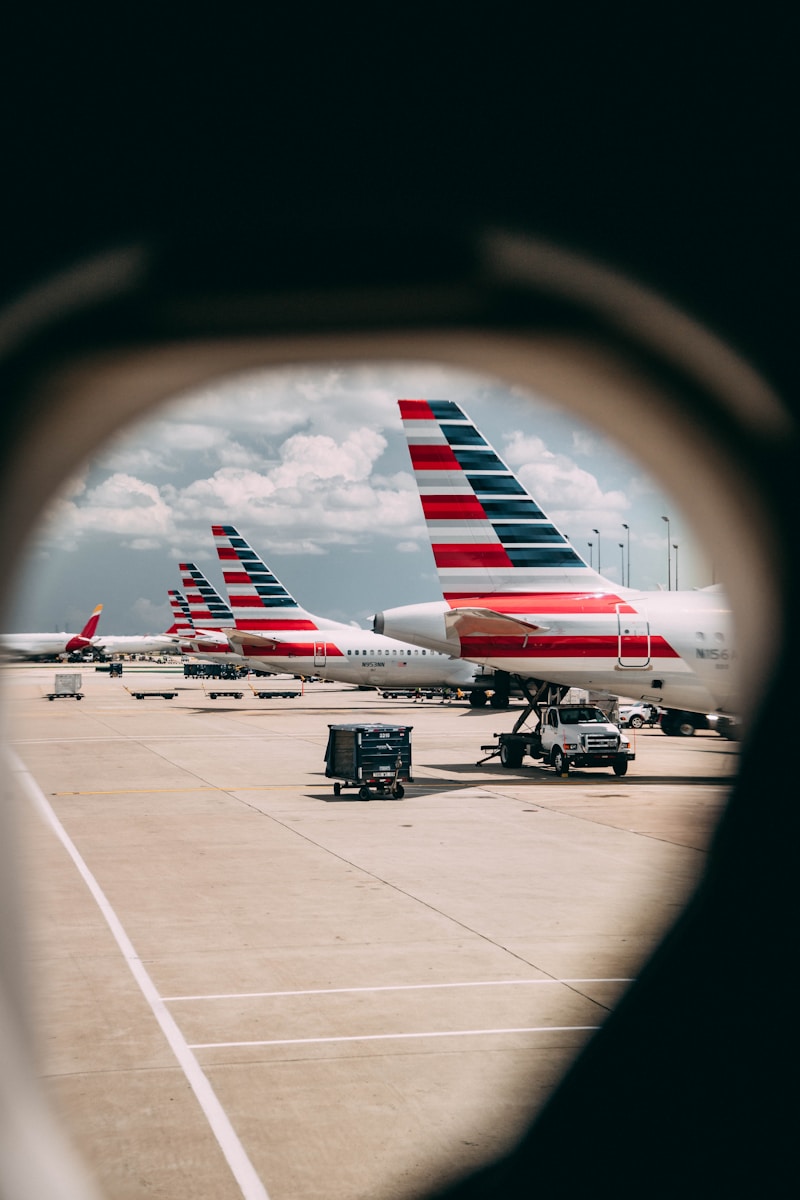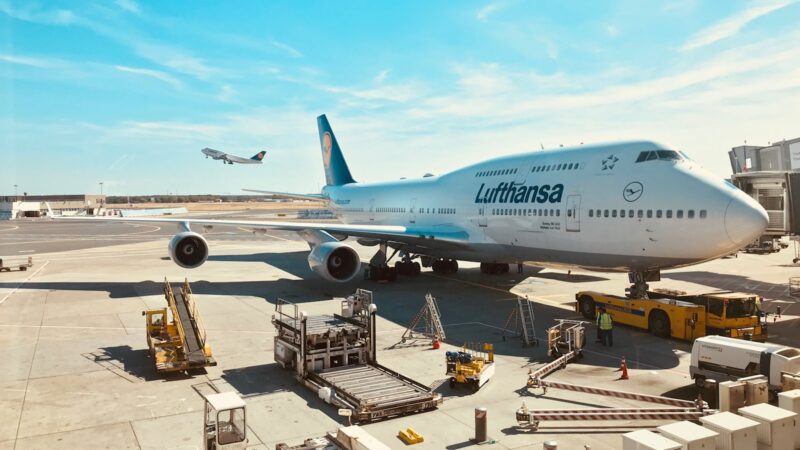Table of Contents
ToggleAmerican Airlines vs United Airlines:
When travelers in the United States consider flying domestically or internationally, two major airlines often come to mind: American Airlines and United Airlines. Both carriers have extensive networks, with American Airlines recognized as the nation’s largest in terms of the number of seats offered on departing flights. They serve a significant number of destinations around the world, enabling passengers to travel to over 350 locations in 60 countries with options for regional connections through their partners like American Eagle.
Passengers choosing between the two airlines may also consider factors such as pricing, the frequency of flights, and airline alliances. Pricing comparisons reveal that American and United offer competitive rates that vary based on the distance and timing of the flights, for instance, coast-to-coast flights or international trips to Europe. Flight frequencies are an important aspect as well, with American Airlines conducting over 6,000 flights daily on average, while United operates more than 4500 flights.
Another important consideration is punctuality, a key component of customer satisfaction. Both airlines are committed to maintaining on-time performance, a challenge for any large-scale operator. According to a punctuality report, American had an on-time performance level of 85.1 percent, with United trailing slightly behind. Travelers looking to connect beyond their initial destination may find it relevant that each airline is part of a larger airline alliance. American is a founding member of the oneworld alliance, and United is a member of the Star Alliance, which gives customers access to numerous additional destinations through codeshare agreements.
American Airlines vs United Airlines: Overview
When contrasting American Airlines and United Airlines, one considers various factors such as their storied histories, foundational principles, and their current standings within the global aviation marketplace.
American Airlines vs United Airlines: History and Evolution
American Airlines began its operations in 1936 and has grown to become a leading carrier not just within the United States, but globally. It has a significant presence in both domestic and international markets, connecting a vast array of destinations.
United Airlines, with its roots going back to the founding of Varney Air Lines in 1926, has similarly expanded to serve a large network of routes. It offers comprehensive coverage with a mix of domestic and international flights that cater to passengers from and within the United States.
American Airlines vs United Airlines: Core Values and Mission
American Airlines aligns itself with values of safety, inclusivity, and integrity, aspiring to create a seamless experience for its passengers. Its mission emphasizes the importance of connecting people and fostering understanding through international and domestic travel.
United Airlines upholds a commitment to customer service and operational excellence, with a focus on sustainability as a central part of its mission. These core values drive its operations and strategic decisions, ensuring a responsible role within the airline industry.
American Airlines vs United Airlines: Current Market Position
American Airlines has been identified as the largest airline in the United States by departing seats. It sustains a broad operational scale, with flights to over 350 destinations in 60 countries, positioning it as a formidable entity in the airline sector.
United Airlines, with substantial daily operations, maintains a robust market presence, operating more than 4500 flights per day. Although positioned fourth in terms of busyness among U.S. airlines, it remains a key competitor on both domestic and international levels.
American Airlines vs United Airlines: Fleet and Network
When comparing the fleet and network of American Airlines and United Airlines, distinct characteristics emerge, such as fleet size, variety of aircraft, and the breadth of their route networks.
American Airlines vs United Airlines: Aircraft Types and Age
The fleets of American Airlines and United Airlines are predominantly composed of Boeing and Airbus aircraft. American Airlines has a larger fleet, consisting of over 870 aircraft, including a mix of Boeing 737s, 777s and the wide-body 787 Dreamliner, as well as the Airbus A320 family. United Airlines operates a substantial number of Boeing 767, 777, and the 787 Dreamliner, complemented by Airbus A320 and A350 aircraft. Both airlines continuously update their fleets with newer, more efficient models and retire older aircraft to maintain an optimal balance between aircraft types and age.
American Airlines vs United Airlines: Route Network and Destinations
American Airlines and United Airlines offer extensive networks, connecting passengers to a vast array of destinations worldwide. American, a founding member of the oneworld alliance, offers flights to more than 1,000 destinations. United, part of the Star Alliance, boasts a substantial route network covering 362 destinations. Both carriers operate an extensive domestic network within the United States, as well as varied international routes that provide global connectivity.
Major Hubs and Fortress Hubs
American Airlines’ hubs are strategically located across various key cities including Dallas, Charlotte, and Miami, thereby creating fortress hubs that facilitate a significant volume of connecting traffic. United Airlines, with its strong presence in cities like Newark and San Francisco, also maintains substantial fortress hubs. The airline’s hub system ensures efficient connections for passengers traveling domestically and internationally, amplifying the carriers’ ability to serve more routes effectively.
American Airlines vs United Airlines: Travel Classes and Comfort
When comparing American Airlines and United Airlines, passengers have various options spanning from basic economy to more luxurious classes. Seating comfort, amenities, and services vary significantly across classes.
Economy and Basic Economy Classes
Both American Airlines and United Airlines offer Economy and Basic Economy fares, with Basic Economy being the most cost-effective option. American’s Main Cabin and United’s Economy provide similar amenities, such as complimentary snacks and non-alcoholic drinks, with United offering United Economy with options for extra legroom. Basic Economy restricts seat selection and boarding priority but still includes the standard in-flight experience.
Premium Cabins
For superior comfort, both carriers offer Premium Economy classes: American’s Main Cabin Extra and Premium Economy, and United’s Economy Plus and United Premium Plus. These classes feature extra legroom and wider seats, and on select international flights, passengers enjoy enhanced dining options. American’s Flagship Business Class and United’s Polaris Business Class provide lie-flat business class seats, accelerating the upscale experience with exquisite dining, bedding, and lounge access.
Specialty Classes and Upgrades
At the apex of luxury, American presents Flagship First Class, offering an exclusive check-in area, priority boarding, and access to Flagship Lounges. Meanwhile, upgrades are available for purchase or through loyalty program rewards with both airlines, allowing access to better seating and premium services. Notably, both airlines also cater to business travelers who may seek more private spaces such as those provided by Polaris business class on United.
American Airlines vs United Airlines: Onboard Experience
When comparing the onboard experiences of United and American Airlines, passengers will notice differences in terms of in-flight entertainment and connectivity, dining options and amenities, and choices for seat selection and extra space.
In-flight Entertainment and Connectivity
American Airlines provides passengers with a variety of video entertainment options, including a vast selection of movies, TV shows, and music that can be streamed on personal devices or seat-back screens where available. They ensure travelers stay connected with Wi-Fi services on most flights.
United Airlines similarly boasts an impressive array of in-flight entertainment choices. Seats are often equipped with personal seat-back screens, and there is the option to stream content directly to personal devices. United also offers an extensive Wi-Fi network onboard, ensuring passengers can stay connected above the clouds.
Dining and Amenities
American Airlines offers complimentary snacks and beverages on all flights, with a range of dining options available for purchase on longer flights. On international and certain domestic routes, premium cabin passengers enjoy a multi-course meal and a selection of fine wines and spirits.
United Airlines matches this with their own dining offerings, including free snacks and beverages, and premium dining experiences in the higher travel classes. They also highlight special amenities like Saks Fifth Avenue bedding in their United Business class.
Seat Selection and Extra Space
For seat selection, both airlines provide options that balance comfort and price. American’s seat selection process allows travelers to choose preferred seats for a fee, and they offer an extra legroom option with “Main Cabin Extra.”
United’s Economy Plus gives passengers the opportunity for more comfort and convenience with additional legroom. These seats can be purchased at an added cost, and the premium seating experience includes priority boarding.
American Airlines vs United Airlines: Customer Service and Reliability
In comparing American Airlines and United Airlines, significant factors for travelers include punctuality, service efficiency, baggage handling, and refund policies.
On-Time Performance and Cancellations
American Airlines has demonstrated a commendable on-time performance level of 85.1%, according to the Official Airline Guide’s annual Punctuality League report for 2021. United Airlines, on the other hand, showed a slightly lower on-time performance at 83.5%. When it comes to cancellations, both airlines strive to maintain operations even in challenging circumstances, but unforeseen factors may lead to flight disruptions.
Customer Service Channels
American and United Airlines both offer several customer service channels to assist passengers, including phone support, email, social media, and in-person counters at the airport. Accessibility and responsiveness across these channels are critical for addressing concerns ranging from simple queries to urgent travel disruptions.
Mishandled Baggage and Compensation
In the event of mishandled baggage, both airlines adhere to Department of Transportation regulations, aiming to resolve such issues promptly. Compensation and refund policies are in place to help mitigate the inconvenience caused to passengers. For detailed information on handling such scenarios, travelers can review American Airlines’ and United Airlines’ policies on their official websites.
American Airlines vs United Airlines: Loyalty Programs
When it comes to their loyalty programs, both American Airlines and United Airlines offer comprehensive systems designed to reward frequent flyers. They have structured different tiers of elite status, associated credit cards with distinct travel benefits, and are members of global airline alliances.
Miles and Status Levels
American Airlines operates the AAdvantage program, which includes several tiers of elite status. The initial tier, AAdvantage Gold, is reached after completing 25,000 Elite Qualifying Miles (EQMs) or 30 elite-qualifying segments and accruing $3,000 Elite Qualifying Dollars (EQDs). On the other hand, United Airlines has the United MileagePlus program. Their top tier, Premier 1K, requires 100,000 Premier Qualifying Miles (PQMs) or 120 premier-qualifying segments, and $12,000 Premier Qualifying Dollars (PQDs).
Credit Cards and Travel Benefits
Both airlines partner with credit card companies to offer travel credit cards that earn miles on everyday purchases. American Airlines has tied up with Citi and Barclays, offering cards like the Citi® / AAdvantage® Platinum Select® card, which provides various benefits such as free checked bags and priority boarding. Similarly, United partners with credit card issuers to offer cards like the United℠ Explorer Card, which also affords a suite of travel perks, including two United Club passes annually.
Partnerships and Alliances
The AAdvantage program is a part of the oneworld alliance, which includes other carriers like British Airways, enabling passengers to earn and redeem miles across a global network. United’s MileagePlus is linked with the Star Alliance, the largest of the global alliances, offering an extensive selection of partner airlines for mileage earning and redemption. These partnerships enhance the value of each airline’s loyalty program by broadening the horizon for their frequent flyers.
American Airlines vs United Airlines: Pricing and Extra Fees
When comparing American Airlines and United Airlines, travelers often focus on how much they will spend on baggage and extra service fees as well as what to expect regarding flight credits and refund policies.
Baggage Fees and Policies
American Airlines and United Airlines both charge for checked baggage. Basic Economy fare passengers typically incur a fee for their first checked bag. For American Airlines, the first bag fee usually is $30, with the second bag costing $40. United’s policy is similar, offering the inclusion of checked bags only in premium classes. Carry-on bags are typically allowed without additional fees as long as they meet the airline size requirements, whereas personal items can be brought on board for free with both carriers.
Service and Convenience Charges
Extra fees can apply for various services such as early boarding, seat selection, or inflight amenities. American and United often charge additional fees for services beyond basic transportation. These charges can vary widely depending on the service class, route, and specific requests made by a passenger.
Flight Credits and Refund Policies
Both airlines offer flight credits for cancellations under certain circumstances, but obtaining a refund depends on the fare type purchased and the reason for cancellation. United Airlines may offer flight credits that are applicable to future travel if passengers need to change their bookings. American Airlines has similar policies, with the specifics of refund eligibility clearly outlined in their ticketing agreements. Travelers should review their fare conditions to understand their rights regarding cancellations and changes.
Traveler Feedback and Perception
Evaluating traveler feedback and perception is essential when comparing American Airlines and United Airlines. Both carriers have distinct reputations based on consumer reviews, business traveler preferences, and industry recognition.
Consumer Reviews and Satisfaction
Travelers frequently turn to consumer reviews to gauge the satisfaction of past passengers with American Airlines and United Airlines. On platforms like NerdWallet, they can compare metrics such as rewards programs, with United’s program offering an effective rebate of 4.89%, while American offers a more generous 7.10% rebate. These figures help travelers assess which airline might provide them with greater value for money.
Business Traveler Preferences
For business travelers, priorities often include schedule reliability and comfort during their journey. According to data from the Official Airline Guide (OAG), American Airlines boasted an on-time performance level of 85.1 percent, closely followed by United Airlines’ 83.5 percent, as detailed in a Better Wander report. This slight difference could influence the decision-making of business travelers who rely on punctuality for their trips.
Industry Awards and Recognition
Industry awards serve as a benchmark for overall airline quality and performance. American Airlines and United Airlines both have achieved significant industry recognition. Through partnerships with global alliances such as oneworld and Star Alliance, these carriers have expanded their reach, with American connecting passengers to over 1,000 destinations, and United offering a similarly extensive network. Awards in categories such as quality of service, innovation, and operational excellence are often highlighted by review sites, which showcase each airline’s standings in the industry.
American Airlines vs United Airlines: Comparative Analysis
In evaluating American Airlines and United Airlines, this section will specifically focus on their market performance and individual operational strengths and weaknesses, factors that are crucial for both industry positioning and consumer choice.
Market Share and Competitor Comparison
American Airlines and United Airlines are two of the largest carriers in the United States. According to recent data, American holds a significant market share, competing closely with Delta Airlines for the top position. United Airlines, while not leading, is still a major player and ranks as the world third largest airline by some measures. Other competitors in the market include Southwest Airlines, known for its large domestic network, and Alaska Airlines, which has a strong presence on the West Coast. JetBlue, Frontier, and Allegiant are also notable for their market presence, each with distinct strategies, such as JetBlue’s customer-centric approach and Frontier’s low-cost model.
- Delta Airlines: Often competes for first place in market share with American Airlines
- JetBlue: Smaller market share but noted for customer service
- Alaska Airlines: Strong West Coast network
- Southwest Airlines: Large domestic carrier
- Frontier: Known for low-cost fares
- Allegiant: Targets smaller markets with less frequent service
Strengths and Weaknesses
American Airlines is highly regarded for its extensive network and hub presence in key cities, offering a vast array of domestic and international destinations. One of the reported strengths of American Airlines is its on-time performance level, which was noted in a report by the Official Airline Guide (OAG). However, it has faced challenges in areas such as customer satisfaction and fleet age.
United Airlines, meanwhile, merged with Continental Airlines in 2010, has leveraged its strong global alliance with Star Alliance to expand its international reach. United has been recognized for its business class services and a commitment to sustainability through investments in newer, fuel-efficient aircraft. On the flip side, it has been slightly behind in on-time performance compared to American Airlines, as reported by NerdWallet.
The landscape of U.S. airlines remains competitive, with each carrier exhibiting particular strengths and weaknesses that cater to different passenger needs, making a comparative analysis essential for informed travel decisions.
American Airlines vs United Airlines: Current Challenges and Future Outlook
In the competitive landscape of commercial aviation, American Airlines and United Airlines, two of the busiest U.S. airlines, face both unique and shared challenges. Their future trajectory is poised on how they navigate current economic pressures and leverage innovation to remain at the forefront of both domestic and international travel markets.
Economic and Industry Challenges
The airline industry is still grappling with the financial fallout of the pandemic, and both American Airlines and United Airlines have had to confront the harsh realities of fluctuating demand, especially on lucrative routes such as New York to Los Angeles. While United has been focusing on recovering its position, American has shown resilience with a forecast for a profitable 2023, despite industry concerns over rising operational costs that could dampen the outlook.
- American Airlines cited strong travel demand as a precursor for its profit forecast.
- United Airlines strategizes on recovering with a focus on long-haul business class offerings to stay competitive.
Innovation and Future Plans
In response to Chapter 11 bankruptcy reorganizations, airlines like American and United have been forced to innovate more aggressively. Their future plans include investment in more fuel-efficient fleets and expansion of international flights.
- American Airlines aims to capitalize on domestic travel while refurbishing its long-haul fleet.
- United Airlines is expanding its international travel routes, aiming to redefine passenger experience.
Conclusion
When choosing between American Airlines and United Airlines, passengers should consider their priorities in terms of cost, convenience, and amenities.
Cost
American Airlines may offer lower costs on certain routes, such as a flight from Miami to New York, which can be a decisive factor for those traveling on a budget.
Convenience
However, convenience factors such as flight schedules, destinations, and on-time performance also play critical roles. American Airlines serves over 350 destinations and has a reported on-time performance of 85.1 percent, as highlighted by a report from Better Wander, which may tilt the balance for travelers with tight schedules or frequent flyers to less-common destinations.
Comfort and Amenities
As for comfort and in-flight amenities, some flyers might prefer United’s Polaris business class for its privacy features. Those looking for premium services may find United Airlines to be more consistent in what they offer across various aircraft types.
Passengers are encouraged to assess their individual requirements and preferences, including cost, schedule, route availability, comfort, and service level, before making a decision. Both airlines have their strengths, and the best choice will vary depending on the specific needs of each traveler.
American Airlines vs United Airlines: Frequently Asked Questions
This section addresses common queries regarding the differences and comparisons between American Airlines and United Airlines, focusing on specific aspects such as in-flight services, seating, economy class features, customer satisfaction, onboard amenities, and loyalty programs.
What are the key differences in international flight services between American Airlines and United Airlines?
American Airlines and United Airlines both offer extensive international services. American is a founding member of the oneworld alliance, which provides access to a global network of destinations including partnerships with British Airways and Delta Airlines. United, part of the Star Alliance, offers a network of nearly 2,000 destinations worldwide, with a significant presence in the Asia-Pacific region.
How do seat comfort and legroom compare on American Airlines versus United Airlines?
Seat comfort and legroom can vary by aircraft and class of service, but both airlines strive to provide a comfortable experience. Legroom in the economy sections might be similar, with varying reviews from passengers on personal space and seat ergonomics.
In terms of economy class, how do American Airlines and United Airlines differ?
Both airlines have comparable economy class offerings, including in-flight entertainment, food and beverage options, and paid Wi-Fi. However, the specifics of each service, like extra legroom in Economy Plus by United, or American’s Basic Economy restrictions, can tip the scales for some travelers based on their preferences.
Which airline has a better reputation for customer satisfaction: American Airlines or United Airlines?
Customer satisfaction scores can fluctuate based on various factors including punctuality, service quality, and problem resolution. Recent reports suggest that American Airlines had a higher on-time performance level compared to United, which could influence customer satisfaction.
What are the on-board entertainment and amenities like when comparing American Airlines with United Airlines?
Both airlines invest in on-board entertainment systems, offering a range of movies, TV shows, music, and games. In some cases, United’s business class, known as Polaris, offers a high level of privacy and amenities, with features consistent across its fleet, including on 787-8 business class aircraft.
How do the frequent flyer programs of American Airlines compare to those of United Airlines?
The frequent flyer programs of both airlines reward loyal customers with points or miles for flights and partnerships, which can be redeemed for flights, upgrades, and other services. According to NerdWallet’s analysis, United’s program yields an effective 4.89% rebate, while American’s AAdvantage Program may offer more benefits for certain flyers but varies based on flying frequency and spending with partners.


















